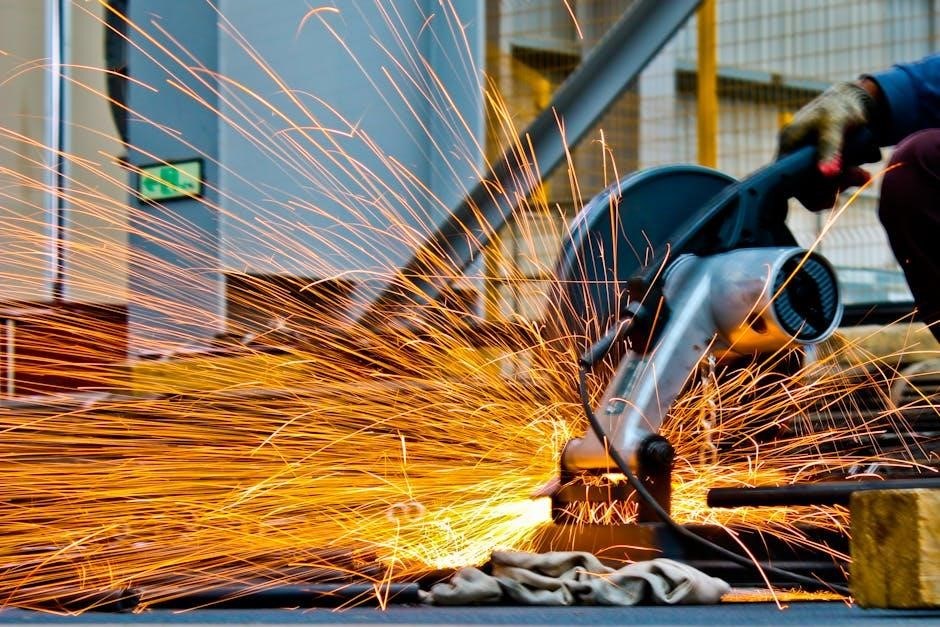
A gated manual transmission is a type of gearbox featuring a physical gate mechanism, often found in high-performance vehicles, designed for precise driver control and smooth shifting.
1.1 Definition and Overview
A gated manual transmission is a type of manual gearbox that incorporates a physical gate mechanism to guide the gearshift through specific pathways, ensuring precise and deliberate gear engagement. This design feature, often found in high-performance and racing vehicles, enhances driver control by eliminating the ambiguity of gear selection. Unlike traditional manual transmissions, which rely on a floating gearshift mechanism, the gated system uses a metal gate embedded in the console to direct the shifter. This setup minimizes accidental gear shifts and provides a more tactile, engaging driving experience. The gated manual transmission is celebrated for its mechanical precision and is commonly associated with premium sports cars and motorsport applications. Its distinctive “click-clack” sound during shifting has become synonymous with performance driving culture. This transmission type requires deliberate and skilled operation, making it a favorite among enthusiasts who value direct mechanical feedback and control.
1.2 Historical Background
The gated manual transmission traces its origins to early 20th-century racing applications, where precise gear control was essential. Early models emerged in the 1950s, particularly in European sports cars, with Ferrari and Porsche pioneering the design. These transmissions featured a physical gate mechanism to guide the shifter, reducing accidental gear shifts during competitive driving. The gated system evolved from earlier manual transmissions, incorporating innovations like the reverse lockout and more defined gear gates. By the 1960s, it became synonymous with high-performance vehicles, offering drivers unparalleled control and tactile feedback. The design gained popularity in motorsports, where its durability and precision proved advantageous. Over time, the gated manual transmission became a hallmark of premium sports cars, blending mechanical sophistication with driver engagement. Its historical development reflects the pursuit of performance and driving excellence, cementing its place in automotive history.

Design and Components
A gated manual transmission features a physical gate mechanism, typically made of metal, inlaid into the console, alongside a robust gearbox housing gears, shafts, and synchronizers for smooth operation and durability.
2.1 Physical Gate Mechanism
The physical gate mechanism in a gated manual transmission is a defining feature, typically constructed from durable metal and integrated into the console. This mechanism serves as a barrier between gear selections, preventing accidental shifts and ensuring precise control. The gate is designed to guide the gear lever smoothly through each position, enhancing the driving experience. Its robust construction ensures longevity and performance under rigorous conditions. The gate mechanism is a critical component that distinguishes gated transmissions from other manual setups, offering a tactile and deliberate shifting process. This design not only improves driver engagement but also minimizes mechanical wear by reducing unintended gear engagement. The physical gate mechanism is a testament to the engineering focused on delivering both functionality and driver satisfaction in high-performance vehicles.
2.2 Gearbox Construction
The gearbox in a gated manual transmission is built with precision and durability in mind, featuring a robust casing typically made from high-strength materials like aluminum or steel. The internal components, including gears, shafts, and bearings, are engineered to withstand the stresses of high-performance driving. The gearbox is designed to maintain optimal gear alignment and minimize wear, ensuring smooth and consistent operation. Cooling systems, such as oil lubrication, are often integrated to manage heat generated during intense use. The construction emphasizes strength and reliability, making it suitable for both racing and everyday driving. This sturdy design ensures the gearbox can handle high torque and repeated shifting without compromising performance or longevity.
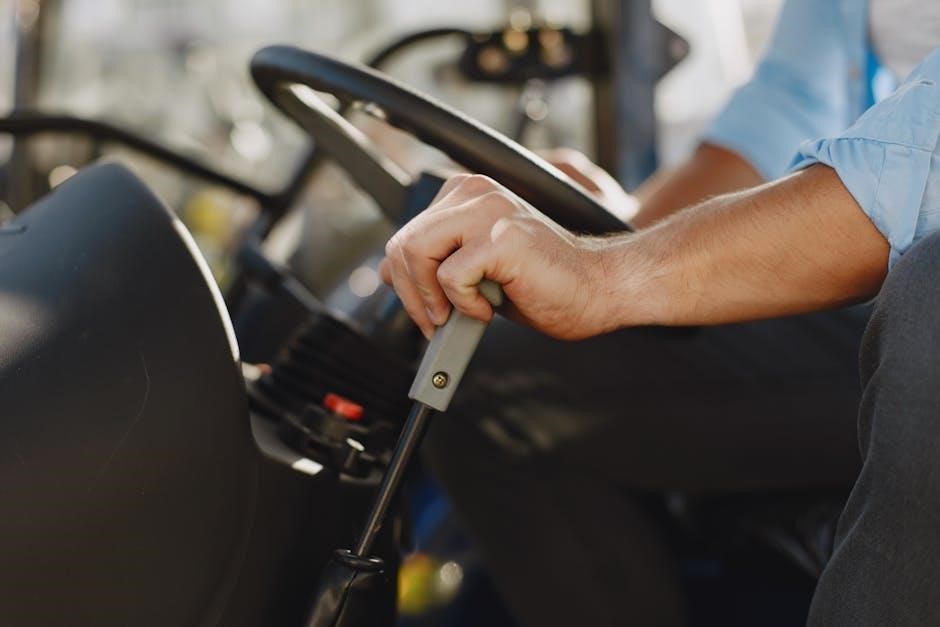
Operation and Functionality
A gated manual transmission operates via a physical gate system, enabling smooth, precise shifting through a sequential gate mechanism. Drivers engage gears manually, ensuring direct control and mechanical connection, ideal for high-performance driving.
3.1 Shifting Mechanism
The shifting mechanism in a gated manual transmission involves a gear lever moving through a physical gate, guided by notches that align with each gear position. This design enhances precision by restricting the lever’s movement to specific paths, reducing the likelihood of misshifts. The gate typically features detents or spring-loaded stops that provide a tactile feedback, ensuring the lever stays in the intended gear. The driver must deliberately move the lever through these gates, often accompanied by a distinct mechanical click, which confirms gear engagement. This system is particularly favored in high-performance and racing applications, where quick, accurate shifts are critical. The gated mechanism contributes to a more engaging driving experience by providing clear, defined gear transitions, though it may require more driver skill and deliberate action compared to other manual transmissions.
3.2 Gear Engagement Process
The gear engagement process in a gated manual transmission involves a precise mechanical sequence. When the driver moves the gear lever through the gate, it aligns with a specific gear notch. A detent spring provides resistance, ensuring the lever stays in position until deliberate movement is applied. Once aligned, the driver presses the clutch pedal, disengaging the engine from the current gear. The synchronizer rings then match the speed of the selected gear to the transmission input shaft, allowing smooth engagement. A distinct mechanical “click” confirms the gear is locked in place. This process requires careful coordination between the clutch, accelerator, and gear lever, particularly in high-performance driving scenarios. The gated mechanism ensures that each gear engagement is deliberate and precise, minimizing the risk of accidental misshifts and enhancing driver control. This level of mechanical interaction is a hallmark of gated manual transmissions.

Advantages of Gated Manual Transmission
A gated manual transmission offers precise driver control, durability, and high performance, ideal for racing and high-performance vehicles, enhancing mechanical feedback and driving experience with instant, delay-free gear shifts;
4.1 Precision and Driver Control
A gated manual transmission excels in deliveringPrecision and driver control, thanks to its direct mechanical connection between the driver and the gearbox. The physical gate mechanism ensures a clear, defined path for gear shifts, reducing ambiguity and providing a tactile experience. This design allows drivers to feel each gear engage with a satisfying mechanical feedback, enhancing the sense of control and connection to the vehicle. In high-performance driving scenarios, such as racing or spirited driving, this precision is critical, enabling quick and deliberate shifts that can make a significant difference in performance. The gated system also minimizes the risk of accidental misshifts, as each gear requires intentional movement through the gate, fostering a more deliberate and engaged driving style. This level of control is particularly prized by driving purists and enthusiasts who value a direct, unfiltered connection to their vehicle.
4.2 Durability and Performance
Gated manual transmissions are renowned for their durability and exceptional performance capabilities, making them a staple in high-performance and racing applications. Constructed with robust materials and precise engineering, these gearboxes are designed to withstand the rigors of intense driving conditions, including high torque and frequent shifting. The mechanical simplicity of the gated system reduces the likelihood of component failure, while the direct connection between the driver and the gearbox ensures efficient power delivery. This results in quicker acceleration and smoother power transitions, which are critical in competitive environments. Additionally, the ability to handle high-stress scenarios without compromising reliability makes gated manual transmissions a preferred choice for both professional racers and enthusiasts seeking ultimate driving performance. Their enduring reputation is built on a legacy of strength and unwavering performance under extreme conditions.

Disadvantages and Challenges
Gated manual transmissions are complex, leading to higher production costs and maintenance needs. Their intricate design increases the risk of mechanical issues if not properly assembled or maintained.
5.1 Complexity of Design
The gated manual transmission is notable for its intricate design, which incorporates a physical gate mechanism to guide the gear selector through specific pathways. This complexity requires precise engineering to ensure smooth and accurate gear engagement. The gearbox often features additional components, such as detent pins and springs, to maintain gear position and prevent misshifts. While this design enhances driver control, it also increases the difficulty of manufacturing and maintenance. The weight and space requirements of the gated mechanism can further complicate installation in certain vehicles. Overall, the sophistication of its design makes it less accessible for mass production and more suited for high-performance applications where precision and durability are critical. This complexity is a significant trade-off for the benefits it provides in driving experience and reliability.
5.2 Higher Cost
The gated manual transmission is typically more expensive than standard manual transmissions due to its advanced design and specialized components. The intricate gate mechanism, precision-engineered gearbox, and high-quality materials contribute to increased production costs. Additionally, the labor required for assembly and tuning is greater, further driving up the price. Maintenance and repairs also tend to be more costly, as specialized tools and expertise are often needed. This higher cost limits the accessibility of gated manual transmissions to premium or high-performance vehicles, where the added expense is justified by enhanced driving dynamics and exclusivity. As a result, this transmission type remains a niche option, primarily appealing to enthusiasts and manufacturers focused on delivering exceptional performance and craftsmanship.

Maintenance and Care
Regular lubrication checks and inspections are crucial to ensure optimal performance. Proper fluid levels and component inspections help prevent wear and extend the transmission’s lifespan.
6.1 Lubrication Requirements
Lubrication is critical for maintaining the performance and longevity of a gated manual transmission. Synthetic oils are often recommended due to their superior viscosity index and thermal stability, ensuring smooth gear engagement even under extreme conditions.
Regular fluid level checks are essential, as low levels can lead to increased wear and potential damage. Owners should consult the manufacturer’s guidelines for the correct type and amount of lubricant required. Proper maintenance also involves periodic fluid changes to remove contaminants and degrade additives, ensuring optimal transmission health and functionality over time.
6.2 Common Maintenance Issues
Common maintenance issues with gated manual transmissions often stem from improper lubrication and excessive wear on synchronizers and gear teeth. Over time, these components can degrade, leading to difficulty in shifting gears smoothly.
Another prevalent issue is the wear of the physical gate mechanism, which can cause misalignment and inconsistent shifting. Regular inspection and replacement of worn parts are crucial to prevent these problems from escalating. Additionally, ensuring the correct fluid levels and using high-quality lubricants can significantly reduce the risk of premature wear and tear. Addressing these issues promptly helps maintain the transmission’s performance and extends its lifespan. Proper maintenance is essential to uphold the precision and control that gated manual transmissions are known for.

History and Evolution
Gated manual transmissions originated in early 20th-century racing, evolving from basic gearboxes to precision-engineered systems with advancements in materials and design, now integral to high-performance vehicles.
7.1 Early Models and Development
The concept of gated manual transmissions emerged in the early 20th century, primarily in Europe, as a response to the need for more precise and durable gearboxes in racing applications. Early models, such as those developed by Ferrari and Porsche, featured rudimentary gate mechanisms that allowed drivers to engage gears with greater accuracy. These systems were often bespoke, designed for specific racing cars, and relied on mechanical linkages to operate the gearbox. The 1950s and 1960s saw significant advancements, with the introduction of synchronized gearboxes and the refinement of the gate mechanism to reduce wear and improve shifting smoothness. By the 1970s, gated manual transmissions had become synonymous with high-performance vehicles, offering drivers unparalleled control and reliability. This era laid the foundation for the modern gated manual transmissions used in motorsports and luxury cars today.
7.2 Modern Advances
Modern gated manual transmissions have evolved significantly, incorporating advanced materials and technologies to enhance performance and efficiency. Contemporary designs often feature lightweight components, such as carbon fiber and titanium, reducing overall weight while maintaining strength. Electronic integration has also become prevalent, with systems like automated rev-matching and adaptive gear ratios optimizing driver experience. Additionally, modern gated transmissions frequently include advanced lubrication systems and optimized gear tooth designs to minimize wear and maximize longevity. These innovations ensure that gated manual transmissions remain a preferred choice for high-performance and racing applications, blending tradition with cutting-edge engineering to deliver exceptional precision and durability. The integration of hybrid systems further highlights the adaptability of this technology, ensuring its relevance in an evolving automotive landscape.
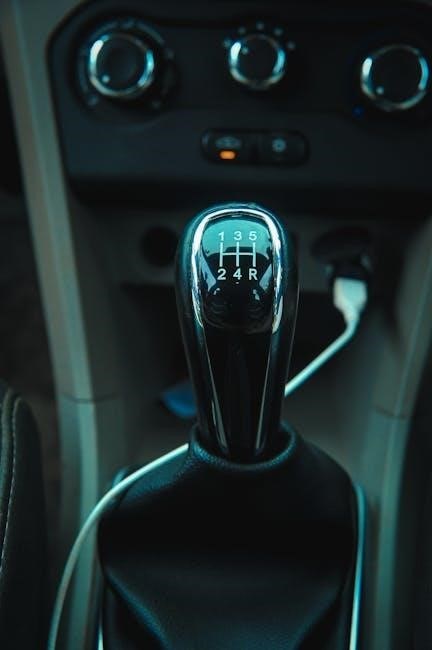
Applications in Automotive Industry
Gated manual transmissions are primarily used in high-performance vehicles and racing, where precise control and durability are crucial, offering a unique driving experience.
8.1 Racing and Motorsports
Gated manual transmissions are widely used in racing and motorsports due to their precision, durability, and ability to withstand high-stress environments. The physical gate mechanism provides a direct and tactile shifting experience, allowing drivers to maintain control during intense maneuvers. In rally racing and endurance events, these transmissions are favored for their reliability and responsiveness. The absence of electronic aids ensures a pure connection between the driver and the vehicle, which is critical in competitive settings. Additionally, the robust construction of gated manual transmissions makes them ideal for high-torque applications and aggressive driving styles common in motorsports. Their popularity in classic racing cars, such as the Porsche 911 and Ferrari 250 GT, further highlights their significance in the automotive racing world.
8.2 High-Performance Vehicles
Gated manual transmissions are synonymous with high-performance vehicles, offering unparalleled driver engagement and control. These gearboxes are typically found in luxury sports cars where precision and responsiveness are paramount. The mechanical gate system provides a satisfying tactile feedback, making every shift a deliberate and immersive experience. High-performance vehicles benefit from the transmission’s ability to handle high torque and power, ensuring optimal performance even under extreme conditions. Additionally, the durability and reliability of gated manual transmissions make them a preferred choice for premium automotive brands. Their presence in iconic models like the Ferrari 250 GT and Porsche 911 underscores their reputation as a cornerstone of high-performance driving, blending tradition with technological excellence to deliver an unparalleled motoring experience.
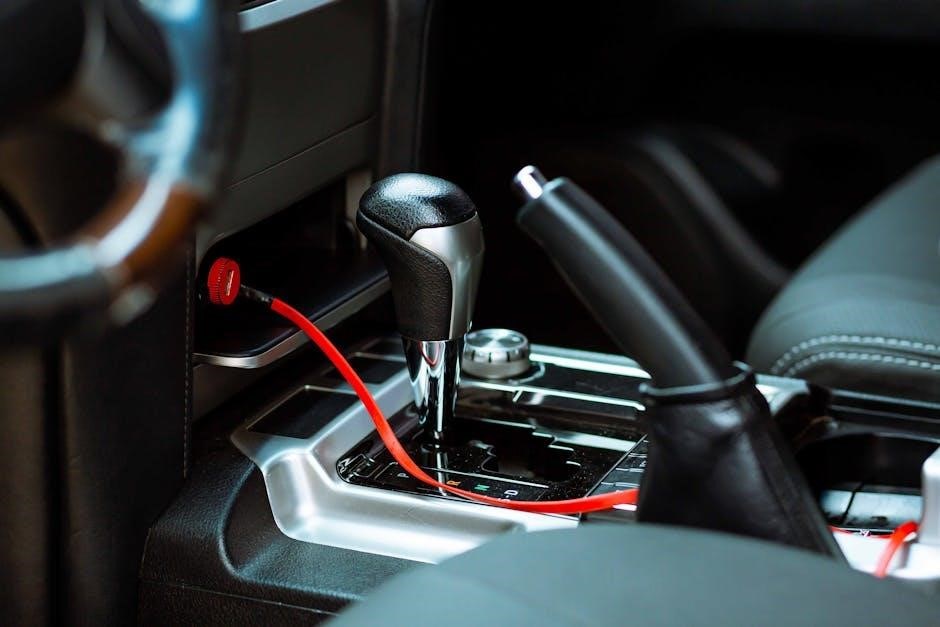
Notable Examples
Classic examples like the Ferrari 250 GT and Porsche 911 showcase gated manual transmissions, renowned for their durability, mechanical precision, and the exhilarating driving experience they deliver.
9.1 Ferrari 250 GT
The Ferrari 250 GT is a iconic sports car that prominently features a gated manual transmission, a hallmark of its design. This system provides drivers with exceptional control and precision, enhancing the overall driving experience. The 250 GT’s transmission is celebrated for its durability and seamless gear engagement, making it a favorite among enthusiasts. Its historical significance is underscored by its presence in various racing and automotive events, showcasing the transmission’s reliability and performance. The gated mechanism adds a touch of elegance to the car’s interior, reflecting Ferrari’s commitment to both aesthetics and functionality. As a result, the 250 GT remains a symbol of automotive excellence and innovation in the realm of manual transmissions.
9.2 Porsche 911
The Porsche 911 is renowned for its use of a gated manual transmission, a feature that has become synonymous with its driving experience. This system, with its distinct metal gate, offers precise control and smooth gear transitions, making it a favorite among driving enthusiasts. The 911’s transmission is celebrated for its durability and performance, perfectly complementing the car’s iconic rear-engine design. Over the years, the gated manual transmission in the 911 has evolved, yet it remains a testament to Porsche’s commitment to driving purity. Its inclusion in various high-performance models underscores its importance in delivering an engaging and exhilarating drive. The 911’s gated transmission is not just a functional component but also a symbolic element of the car’s heritage and appeal.
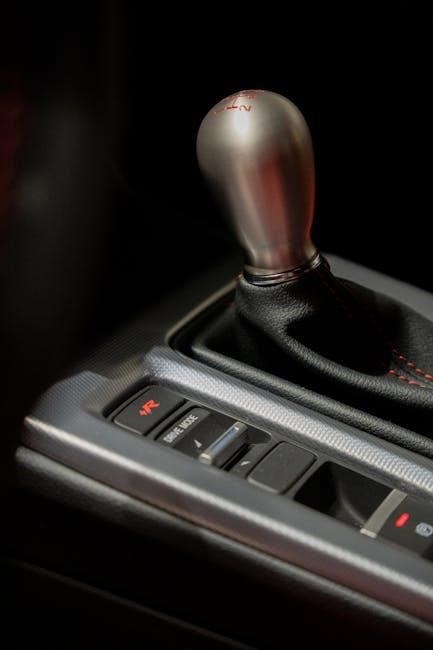
Future Trends and Innovations
Future trends for gated manual transmissions include integration with hybrid systems, combining efficiency with performance. Advances in materials and digital controls promise enhanced precision and driver engagement.
10.1 Integration with Hybrid Systems
The integration of gated manual transmissions with hybrid systems represents a significant leap in automotive innovation. By combining the precision of a manual gearbox with the efficiency of hybrid technology, manufacturers aim to create vehicles that balance performance and sustainability. This integration allows for smoother transitions between electric and combustion engine power, enhancing overall driving efficiency. Advanced materials and digital controls are being developed to optimize this synergy, ensuring seamless operation. Additionally, hybrid systems can mitigate the inherent complexity of gated transmissions, offering a more refined and efficient driving experience. This trend is expected to redefine the future of high-performance vehicles, blending traditional driving engagement with modern eco-friendly technology. The potential for reduced emissions and improved fuel economy makes this integration a cornerstone of future automotive advancements.